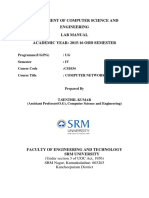Using Python and Sockets: System Power Supply Programming
Using Python and Sockets: System Power Supply Programming
Uploaded by
takaca40Copyright:
Available Formats
Using Python and Sockets: System Power Supply Programming
Using Python and Sockets: System Power Supply Programming
Uploaded by
takaca40Original Description:
Original Title
Copyright
Available Formats
Share this document
Did you find this document useful?
Is this content inappropriate?
Copyright:
Available Formats
Using Python and Sockets: System Power Supply Programming
Using Python and Sockets: System Power Supply Programming
Uploaded by
takaca40Copyright:
Available Formats
W H I T E PA P E R
System Power Supply Programming
Using Python and Sockets
Python programming is growing in popularity as it is easy to learn and available
free of charge from www.python.org. Python can be used with sockets to send Advantages of Python
for test engineering
SCPI commands to a system power supply connected to the LAN. This article
• Free, open source
will describe four functions used to send SCPI commands and receive data from
• Easy to learn
a system power supply. To get started programing you will need to download a
• Extensive libraries
free version of Python and the free environment Microsoft Visual Studio Code. If
• Integrates well with other
you are not familiar with Python, it supports a legacy 2.x version plus the newest languages
version 3.x. The general rule of thumb is to use the latest version (3.7) unless
you have a large installed base of 2.x code.
Program Structure
The code is structured to emphasize programming the system power supply.
Four functions were created to make it easy to explain the power supplies
commands (SCPI) without having to understand Python or sockets. For example,
outPut(‘*RST’) sends the SCPI command *RST to the power supply. Future
white papers will be more focused on the power supply SCPI commands. This
white paper will provide a little background on Python, sockets and the four
functions used to send the SCPI commands.
Find us at www.keysight.com Page 1
Four functions used to communicate with Power Supply
Open Socket: openSocket(IPaddr,port) – Create a connection to IP address & port
Close Socket: closeSockets() – Closes the socket connection
Output: outPut(cmd1) – Sends SCPI commands as a string
Enter: enTer() – receives instrument data as a string
Figure 1. Four functions were created to send the SCPI commands and receive the
measurement data from the power supply.
Python
If you are new to Python, you can find many useful tutorials and code snippets
to explain every Python concept. One of the core benefits of Python is that it is easy
to learn. There are a couple of things to keep in mind. Python is whitespace sensitive
and uses indentation for flow control. Using the development environment Visual Studio
Code helps with creating the proper indenting. Figure 2. provides an example of using
white space (indenting) for flow control. Typically, variables are not declared or provided
a data type and can be re-used. Although, a global declaration is available to share
variables and their values between all functions.
def outPut(cmd1): # Send SCPI command via sockets
cmd1 = cmd1 + ‘\n’
skt.send(cmd1.encode(‘ASCII’))
Figure 2. Python uses indenting for flow control.
Sockets
Socket connections provide a way to communicate with an instrument connected via
LAN. System power supplies often use the LAN interface as they are frequently located
remotely in a test system. If you are interested in further exploring sockets, our power
supplies use internet domain, streaming sockets. Software must use the same type
of socket along with an IP address and port to connect. Sockets have built-in error
trapping which is helpful for debugging. In addition, the code example, Figure 3 is
using the socket-timeout feature to trap any errors that occur in communicating with
the instrument.
Find us at www.keysight.com Page 2
Open Socket Function
An IP address and port number are passed to the open socket routine. The Python
code is shown in Figure 3. A global connection allows the other functions to be able to
access it. Error and exceptions are handled in Python with a try-except statement. The
first try-except routine defines the socket type, internet/streaming and sets the timeout.
Our second try-except routine specifies the address for our socket connection. If the
instrument is offline or has been assigned a new address an “Error connecting
to socket on instrument: timed out” will occur. The error string is assigned
to e using the as command. The %s acts as a placeholder for a string inside a print
command. The placeholder is replaced by what follows % which in our case is the
variable e.
def openSocket(IPaddr,port): # Create a connection via sockets
global skt
try:
skt = socket.socket(socket.AF_INET, socket.SOCK_STREAM)
skt.settimeout(8) # 8 second timeout
except socket.error as e:
print(‘Error creating socket: %s’ % e)
sys.exit(1)
try:
skt.connect((IPaddr, port))
except socket.gaierror as e:
print(‘Address-related error connecting to instrument: %s’ % e)
sys.exit(1)
except socket.error as e:
print(‘Error connecting to socket on instrument: %s’ % e)
sys.exit(1)
Figure 3. Python function to open a socket to an instrument.
Find us at www.keysight.com Page 3
Output and Enter Functions
The output and enter functions are straightforward. The power supply receives the SCPI
commands as strings followed by a “newline.” Python uses “/n” to send the code
for a newline. The output function passes a SCPI command along with the new line to
the instrument.
def outPut(cmd1): # Send SCPI command via sockets
cmd1 = cmd1 + ‘\n’
skt.send(cmd1.encode(‘ASCII’))
def enTer(): # Receive instrument data via sockets
dataStr=skt.recv(1024).decode(‘ASCII’)
return dataStr.strip()
Figure 4. Output and Enter functions pass ASCII data to and from the instrument.
The enter function receives ASCII data from the instrument. Spaces and escape codes
are stripped from the string. Print(enTer()) will display the string received from the
instrument. The routine can return numerical data or messages.
Close Socket Function
The closeSockets() function is a one-line function skt.close(). It was created
to keep symmetry with the openSocket()routine. Closing the sockets releases the
resources associated with the connection.
Find us at www.keysight.com Page 4
Summary
Python along with sockets provides a simple way to send SCPI commands and receive
data from a system power supply. Using the four functions openSocket(), outPut(),
enTer(), and closeSockets() makes it easy to view the SCPI commands being
sent to the instrument. We hope that you use the attached sample program and modify
it for your application. The sample program sets the power supplies voltage
then measures the voltage and current. Keep in mind that our call centers do not have
the staffing to support sockets or Python but can help you with questions about our
power supplies.
# An example program to configure channel 1 of a modular DC power
# supply. The program follows the flow: open resources, reset,
# configure, main body, release resources. The hardware used is an N6700C
# and an N6762A
import socket, sys, time
def outPut(cmd1): # Send SCPI command via sockets
cmd1 = cmd1 + ‘\n’
skt.send(cmd1.encode(‘ASCII’))
def enTer(): # Receive instrument data via sockets
dataStr=skt.recv(1024).decode(‘ASCII’)
return dataStr.strip()
def openSocket(IPaddr,port): # Create a connection via sockets
global skt
try:
skt = socket.socket(socket.AF_INET, socket.SOCK_STREAM)
skt.settimeout(8) # 8 second timeout
except socket.error as e:
print(‘Error creating socket: %s’ % e)
sys.exit(1)
try:
skt.connect((IPaddr, port))
except socket.gaierror as e:
print(‘Address-related error connecting to instrument: %s’ % e)
sys.exit(1)
except socket.error as e:
print(‘Error connecting to socket on instrument: %s’ % e)
sys.exit(1)
def closeSockets(): # Close socket connection
skt.close()
#
# main function
if __name__ == ‘__main__’:
#
# Assign resources
openSocket(‘10.112.158.34’,5025)
Sample program
Find us at www.keysight.com Page 5
#
# Reset & configure mainframe / instrument
outPut(‘*RST’)
outPut(‘DISP:VIEW METER1’) # Single channel meter
print(‘mainframe configured’)
#
# Configure output channel 1
outPut(‘OUTP OFF, (@1)’) # Output off
outPut(‘VOLT 0, (@1)’) # Set voltage to 0
outPut(‘VOLT:PROT:LEV 6, (@1)’) # Set voltage limit 6 V
outPut(‘CURR 1, (@1)’) # Set CC limit 1 A
print(‘channel 1 configured’)
#
# Main body - Output voltages from 0 to 5 V with 1 V increments,
# measure the corresponding voltage and current.
outPut(‘OUTP ON, (@1)’) # Turn output on
for i in range(0, 6, 1): # Step voltage from 0 to 5 V
outPut(‘VOLT ‘ + str(i) + ‘, (@1)’) # Set output voltage
time.sleep(5) # Allow output to settle 5 s
outPut(‘MEAS:VOLT? (@1)’) # Measure voltage
respnse = enTer() # Retrieve data
print(respnse + ‘ V ‘, end=’’) # Print voltage
outPut(‘MEAS:CURR? (@1)’) # Measure current
respnse = enTer() # Retrieve data
print(respnse, ‘A’) # Print current
outPut(‘OUTP OFF, (@1)’) # Turn output off
print(‘loop complete’)
#
# Close socket - release resources
closeSockets()
#
# End
Sample program continued
Learn more at: www.keysight.com
For more information on Keysight Technologies’ products, applications or services,
please contact your local Keysight office. The complete list is available at:
www.keysight.com/find/contactus
Find us at www.keysight.com Page 6
This information is subject to change without notice. © Keysight Technologies, 2019, Published in USA, April 8, 2019, 5992-3827EN
You might also like
- Bro Log VarsDocument6 pagesBro Log Varsanderson medinaNo ratings yet
- Zenith User Manual Mk2 SensorDocument56 pagesZenith User Manual Mk2 SensorArmel Gildas100% (4)
- Using Python and Sockets: System Power Supply ProgrammingDocument6 pagesUsing Python and Sockets: System Power Supply ProgramminghigocNo ratings yet
- Lab Manual (Index)Document24 pagesLab Manual (Index)reddysinfoNo ratings yet
- Techniques of Java Programming: Sockets in Java: Manuel Oriol May 10, 2006Document8 pagesTechniques of Java Programming: Sockets in Java: Manuel Oriol May 10, 2006Vasu KodagantiNo ratings yet
- IPC: Sockets: Assignment No 9a Title ObjectiveDocument3 pagesIPC: Sockets: Assignment No 9a Title Objectivedeepak52764No ratings yet
- CNLab Complete DocumentDocument58 pagesCNLab Complete Documentpavantejareddy85No ratings yet
- Java NetworkingUnit3Document24 pagesJava NetworkingUnit3samreenNo ratings yet
- CS 8581-Lab-ManualDocument39 pagesCS 8581-Lab-ManualAarkaNo ratings yet
- CN LabDocument40 pagesCN LabkeshavnagarcontactlistNo ratings yet
- CN LabDocument63 pagesCN Labdeadpool4072No ratings yet
- Study of Networking Commands Aim:: TcpdumpDocument41 pagesStudy of Networking Commands Aim:: Tcpdumpjanakiraman4103No ratings yet
- Chapter 9 NetworkingDocument13 pagesChapter 9 NetworkingAmit PatelNo ratings yet
- Control Your PC From AnywhereDocument3 pagesControl Your PC From Anywhere20-CM-040 Chilakani Mahesh BabuNo ratings yet
- ECNG3016 Practical 3Document12 pagesECNG3016 Practical 3Marlon BoucaudNo ratings yet
- Chapter 2Document52 pagesChapter 2Beka BekoNo ratings yet
- Internet SocketDocument4 pagesInternet SocketAshish BardhanNo ratings yet
- Stop and Wait Protocol: Ex. No.1 (A) Date: AimDocument53 pagesStop and Wait Protocol: Ex. No.1 (A) Date: Aimbala_07123No ratings yet
- CS8581 Networks Lab ManualDocument67 pagesCS8581 Networks Lab ManualTamilvanan S100% (2)
- Introduction To Socket Programming: Practical - 02Document7 pagesIntroduction To Socket Programming: Practical - 02rent peNo ratings yet
- Exno2 Introduction To Socket Programming Aim: To Study About The Basics of Socket in Network ProgrammingDocument20 pagesExno2 Introduction To Socket Programming Aim: To Study About The Basics of Socket in Network ProgrammingAdamNo ratings yet
- A Bit of HistoryDocument13 pagesA Bit of HistoryPavan KumarNo ratings yet
- Network Programming LabDocument79 pagesNetwork Programming LabAswathy Vineeth100% (1)
- Computer NetworkingDocument33 pagesComputer NetworkingPriyadharshini KNo ratings yet
- CN Lab ManualDocument67 pagesCN Lab ManualsowrishalNo ratings yet
- Document TutorialDocument10 pagesDocument Tutorialneider salgadoNo ratings yet
- Department of Information Technology: Submitted To: Submitted byDocument30 pagesDepartment of Information Technology: Submitted To: Submitted byHemant KumarNo ratings yet
- CN NewDocument53 pagesCN NewMunavvar PopatiyaNo ratings yet
- Updated Computer NetworkDocument27 pagesUpdated Computer NetworkAryan SinghNo ratings yet
- How The Communication Occurs?: PC ClientDocument20 pagesHow The Communication Occurs?: PC Clientnehru444No ratings yet
- Socket ProgrammingDocument16 pagesSocket ProgrammingVivek kumarNo ratings yet
- CS3591 ManualDocument62 pagesCS3591 ManualArockia PravinaNo ratings yet
- Serial Port rs232Document35 pagesSerial Port rs232dokeosNo ratings yet
- 333 - Lab - 6 - 2017 Clarified 4 - 8 - 17Document8 pages333 - Lab - 6 - 2017 Clarified 4 - 8 - 17abdul nurudeenNo ratings yet
- SocketsDocument37 pagesSocketskolle arunkumarNo ratings yet
- B3 - 322070 - Sai Kamble - Assig - 5Document10 pagesB3 - 322070 - Sai Kamble - Assig - 5sai.22220063No ratings yet
- CSE1004 Communications and Networks Fat LabDocument8 pagesCSE1004 Communications and Networks Fat LabNeela Narayanan VenkatramanNo ratings yet
- Laboratory #3 IT Systems Security Lab University of Petroleum and Energy Studies, DehradunDocument5 pagesLaboratory #3 IT Systems Security Lab University of Petroleum and Energy Studies, DehradunMansi BishtNo ratings yet
- Index: S. No. Topic Date Teacher's SignDocument38 pagesIndex: S. No. Topic Date Teacher's SignRahul MalkaniNo ratings yet
- 19P220 Lab - 7Document6 pages19P220 Lab - 7MaheshwaranNo ratings yet
- Computer Networks Lab ManualDocument75 pagesComputer Networks Lab Manualshreekar.nyayapathi23No ratings yet
- Computer Network File Socket ProgrammingDocument26 pagesComputer Network File Socket Programming21bit026No ratings yet
- Worksheet 1.1, 21BCS9666, Avishek KumarDocument8 pagesWorksheet 1.1, 21BCS9666, Avishek KumarAvishek kumarNo ratings yet
- Updated CS22511 CN LAB (S) FiDocument114 pagesUpdated CS22511 CN LAB (S) FirameshNo ratings yet
- TP Socket VB Réseaux InformatiqueDocument11 pagesTP Socket VB Réseaux Informatiquesarra_essaiedNo ratings yet
- SocketDocument31 pagesSocketBindiya RamchurnNo ratings yet
- Enc28j60 - EngDocument10 pagesEnc28j60 - EngGuillaume FayeNo ratings yet
- Bcs Socket ProgrammingDocument38 pagesBcs Socket ProgrammingSana IftikharNo ratings yet
- CS22511 CN Lab (S)Document114 pagesCS22511 CN Lab (S)rameshNo ratings yet
- Control An Arduino From JavaDocument7 pagesControl An Arduino From JavaHarry PratamaNo ratings yet
- 19MS012, EEE Submission, Datir PranavDocument66 pages19MS012, EEE Submission, Datir PranavKartik BhagatNo ratings yet
- CN Lab Manual MITDocument69 pagesCN Lab Manual MITSidharth Sankar100% (6)
- Cse Lab Manual NetworksDocument40 pagesCse Lab Manual NetworksLoganathan RmNo ratings yet
- Lab File: Distributed System Lab (RCS-751)Document30 pagesLab File: Distributed System Lab (RCS-751)Rahul YadavNo ratings yet
- CN LabDocument48 pagesCN Labnaveenbharathi5050No ratings yet
- Introduction To Network ProgrammingDocument22 pagesIntroduction To Network Programmingvalic_foreverNo ratings yet
- CISCO PACKET TRACER LABS: Best practice of configuring or troubleshooting NetworkFrom EverandCISCO PACKET TRACER LABS: Best practice of configuring or troubleshooting NetworkNo ratings yet
- PLC: Programmable Logic Controller – Arktika.: EXPERIMENTAL PRODUCT BASED ON CPLD.From EverandPLC: Programmable Logic Controller – Arktika.: EXPERIMENTAL PRODUCT BASED ON CPLD.No ratings yet
- C Programming for the Pc the Mac and the Arduino Microcontroller SystemFrom EverandC Programming for the Pc the Mac and the Arduino Microcontroller SystemNo ratings yet
- Designing Silicon Carbide (Sic) Based DC Fast Charging System: Key Challenges, Design Considerations, and Building ValidationDocument31 pagesDesigning Silicon Carbide (Sic) Based DC Fast Charging System: Key Challenges, Design Considerations, and Building Validationtakaca40No ratings yet
- PLECS Model Quick Start Guide DS50002997ADocument37 pagesPLECS Model Quick Start Guide DS50002997Atakaca40No ratings yet
- Microzed Chronicles: Device Trees: Search All Content BlogDocument7 pagesMicrozed Chronicles: Device Trees: Search All Content Blogtakaca40No ratings yet
- Getting To Know Vivado: Workshop SeriesDocument4 pagesGetting To Know Vivado: Workshop Seriestakaca40No ratings yet
- Getting To Started With Vivado Workshop Presentation Session1Document4 pagesGetting To Started With Vivado Workshop Presentation Session1takaca40No ratings yet
- Getting To Know Vivado: Course WorkbookDocument54 pagesGetting To Know Vivado: Course Workbooktakaca40No ratings yet
- Working With Vivado P2Document59 pagesWorking With Vivado P2takaca40No ratings yet
- Getting To Know Vivado: Course WorkbookDocument53 pagesGetting To Know Vivado: Course Workbooktakaca40No ratings yet
- Edge AIDocument156 pagesEdge AItakaca4075% (4)
- Dspic Control Board: For Industrial ApplicationsDocument5 pagesDspic Control Board: For Industrial Applicationstakaca40No ratings yet
- Proyectos Con 18f2550 y c18Document63 pagesProyectos Con 18f2550 y c18Garra Crema StoneNo ratings yet
- Kickd Pic32 Ubl ManualDocument18 pagesKickd Pic32 Ubl Manualtakaca40No ratings yet
- Network Setup Guide: Setting Up For Use Over LANDocument32 pagesNetwork Setup Guide: Setting Up For Use Over LANMeshelmoth -srNo ratings yet
- ManualDocument48 pagesManualKhairul Amin SukriNo ratings yet
- Lab - Use A Port Scanner To Detect Open PortsDocument7 pagesLab - Use A Port Scanner To Detect Open PortsAsepNo ratings yet
- Manual Sepam IEC61850 enDocument160 pagesManual Sepam IEC61850 enosmpotNo ratings yet
- Flexman 4 - 1 Installation and Configuration GuideDocument32 pagesFlexman 4 - 1 Installation and Configuration GuideManny MendozaNo ratings yet
- Access Control Policy Report: DC-FWDocument53 pagesAccess Control Policy Report: DC-FWmoamaNo ratings yet
- Configuring Port-Based Traffic ControlDocument14 pagesConfiguring Port-Based Traffic ControlAhmed Al-hamdaniNo ratings yet
- Barracuda Backup AG USDocument71 pagesBarracuda Backup AG USKurniawan Setyo NugrohoNo ratings yet
- FCoE Handbook First-A EbookDocument59 pagesFCoE Handbook First-A Ebookvidododo100% (2)
- Exam 2022 2023Document2 pagesExam 2022 2023Chedi BedhiafiNo ratings yet
- Security Expert - Security Purpose Controller - Configuration GuideDocument66 pagesSecurity Expert - Security Purpose Controller - Configuration GuideHend AlyNo ratings yet
- STULZ WIB8000 G67C 1118 enDocument52 pagesSTULZ WIB8000 G67C 1118 enOctavio Farid Rossi YumhaNo ratings yet
- Ports Required For System Platform 2017 Update 3: Application VersionDocument3 pagesPorts Required For System Platform 2017 Update 3: Application Versionmithun divateNo ratings yet
- Call Home Installation and ConfigurationDocument12 pagesCall Home Installation and ConfigurationEdward Waithaka WaweruNo ratings yet
- Blueprint Network PortsDocument3 pagesBlueprint Network PortsSreedhar ReddyNo ratings yet
- Network SecurityDocument51 pagesNetwork Securityct pentestNo ratings yet
- Laboratory Computer System Security: L2. Examination of N-IDS System (Snort)Document11 pagesLaboratory Computer System Security: L2. Examination of N-IDS System (Snort)ghazellaNo ratings yet
- Parameter For Ss7Document66 pagesParameter For Ss7Khov KuyphengNo ratings yet
- Unicom 802.11g Wireless RouterDocument56 pagesUnicom 802.11g Wireless RouterCristhian XambreNo ratings yet
- Security in HP-UX System Management Homepage (SMH)Document13 pagesSecurity in HP-UX System Management Homepage (SMH)francisbulNo ratings yet
- H12-211-Enu V14.02 PDFDocument194 pagesH12-211-Enu V14.02 PDFAbdul KarimNo ratings yet
- Fortios Handbook 56Document3,447 pagesFortios Handbook 56davidNo ratings yet
- Cyber Security Previous Year Solution 2021Document21 pagesCyber Security Previous Year Solution 202120CS18 SISIR KUMARNo ratings yet
- GPON - 3. OLT140X Web GUIDocument38 pagesGPON - 3. OLT140X Web GUIJanilson LopesNo ratings yet
- DarktraceReport2022-04-01T05 00 00 2022-05-01T04 59 00Document69 pagesDarktraceReport2022-04-01T05 00 00 2022-05-01T04 59 00Chris Granados C.No ratings yet
- Tenda A6 Wireless N150 Mini AP-Router - User GuideDocument97 pagesTenda A6 Wireless N150 Mini AP-Router - User GuideschjaadNo ratings yet
- Java RMIDocument89 pagesJava RMICarlos MatosNo ratings yet
- HackingDocument28 pagesHackingJigar Patel0% (1)





































































































